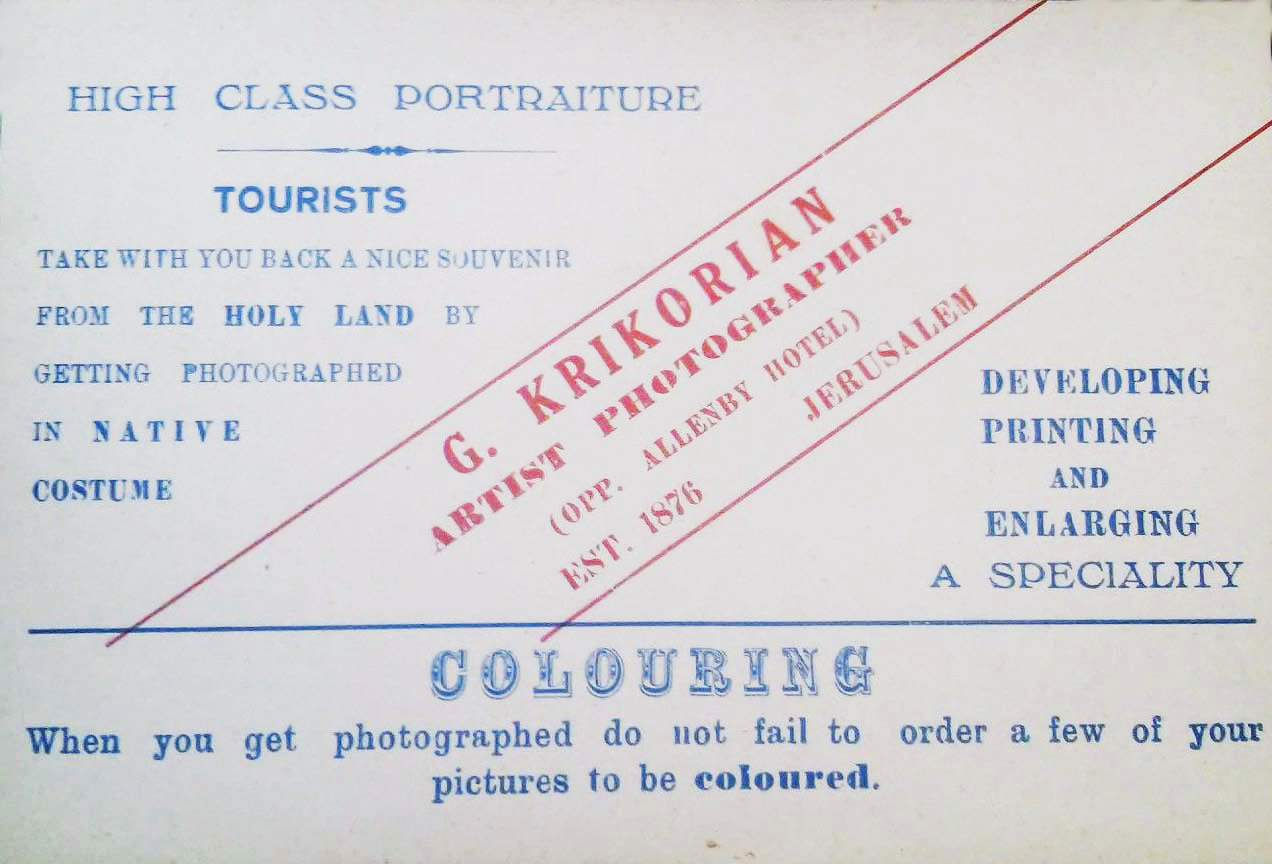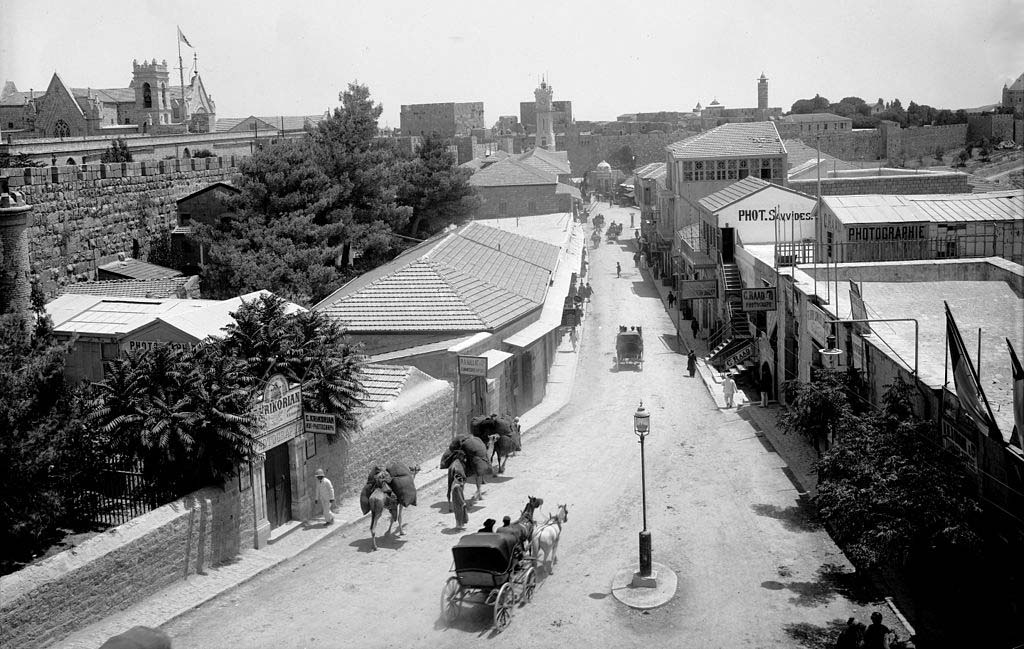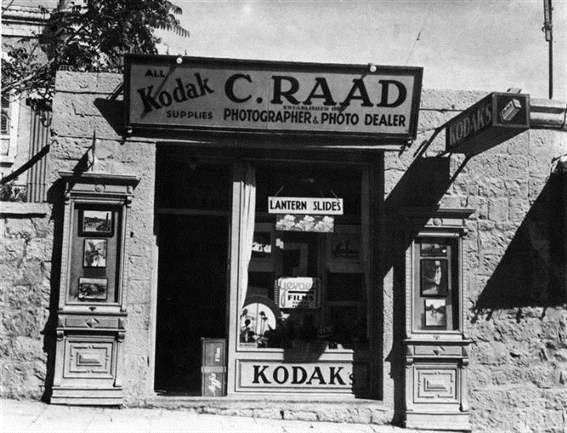
Enter Here To View
Cultural
Cross-Dressing In StudiosEnter Here To View
Tourists In Palestine
No part of this exhibition may be reproduced or transmitted in any form or by any means, electronic, mechanical, photocopying, recording, or otherwise, without prior written permission of Joseph Malikian.
 Tourism poster produced in the early 20th century
Tourism poster produced in the early 20th century
(Malikian Collection) Garabed Krikorian Studio. Western tourist with tour guides, ca. 1900
Garabed Krikorian Studio. Western tourist with tour guides, ca. 1900
(Malikian Collection) Unidentified Studio. Dome of the Rock. German tourists on the grounds of the mosque, February 2, 1899
Unidentified Studio. Dome of the Rock. German tourists on the grounds of the mosque, February 2, 1899
(Malikian Collection) Garabed Krikorian Studio. Dome of the Rock. Western tourists on the steps of the mosque, ca. 1900
Garabed Krikorian Studio. Dome of the Rock. Western tourists on the steps of the mosque, ca. 1900
(Malikian Collection) Unidentified Studio. Dome of the Rock. Western tourists on the steps of the mosque, ca. 1925
Unidentified Studio. Dome of the Rock. Western tourists on the steps of the mosque, ca. 1925
(Malikian Collection) J. Toumayan Studio. Fransiscan Friars with European dignitaries, ca. 1920
J. Toumayan Studio. Fransiscan Friars with European dignitaries, ca. 1920
(Malikian Collection) Unidentified Studio. Western tourists on camp grounds in Palestine, ca. 1880
Unidentified Studio. Western tourists on camp grounds in Palestine, ca. 1880
(Malikian Collection) Unidentified Studio. Western tourists on camp grounds in Palestine, ca. 1880
Unidentified Studio. Western tourists on camp grounds in Palestine, ca. 1880
(Malikian Collection) Studio Bonfils. Western tourists and their guides camping along the Jordan River, ca. 1870
Studio Bonfils. Western tourists and their guides camping along the Jordan River, ca. 1870
(Malikian Collection) Garabed Krikorian & Mitry Studio. 'Bargaining for a photograph,' ca. 1900 (Malikian Collection)
Garabed Krikorian & Mitry Studio. 'Bargaining for a photograph,' ca. 1900 (Malikian Collection)
Enter Here To View
Tourists In Palestine
Enter Here To View
Cultural Cross-Dressing In Studios
No part of this exhibition may be reproduced or transmitted in any form or by any means, electronic, mechanical, photocopying, recording, or otherwise, without prior written permission of Joseph Malikian.
 Daoud Abdo Studio. Tashdjian family, 1929
Daoud Abdo Studio. Tashdjian family, 1929
(Malikian Collection) Daoud Abdo Studio. Hand-colored image. Tashdjian family, 1929
Daoud Abdo Studio. Hand-colored image. Tashdjian family, 1929
(Malikian Collection)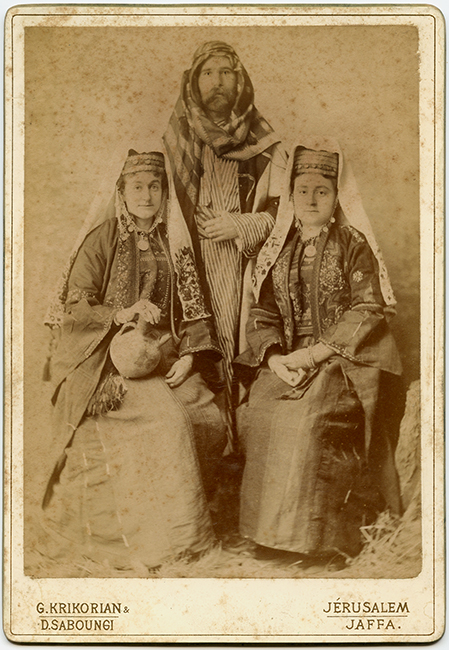 Garabed Krikorian & Daoud Saboungi Studio, ca. 1890
Garabed Krikorian & Daoud Saboungi Studio, ca. 1890
(Malikian Collection) Garabed Krikorian Studio, ca. 1895
Garabed Krikorian Studio, ca. 1895
(Malikian Collection) Garabed Krikorian Studio, ca. 1895
Garabed Krikorian Studio, ca. 1895
(Malikian Collection) Garabed Krikorian Studio, ca. 1900
Garabed Krikorian Studio, ca. 1900
(Malikian Collection)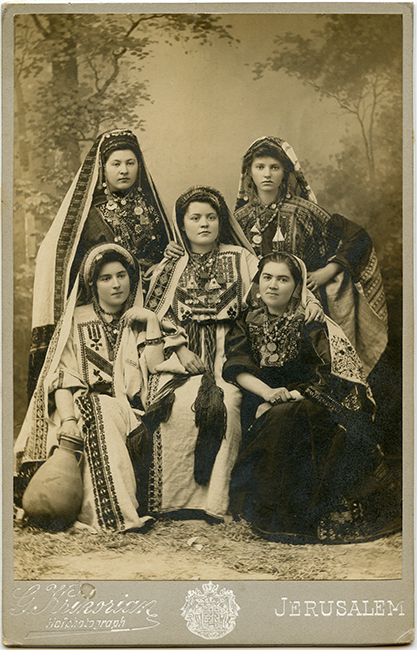 Garabed Krikorian Studio, ca. 1900
Garabed Krikorian Studio, ca. 1900
(Malikian Collection) Garabed Krikorian Studio, ca. 1900
Garabed Krikorian Studio, ca. 1900
(Malikian Collection) A. Haschadour & J. Toumayan Studio, ca. 1900
A. Haschadour & J. Toumayan Studio, ca. 1900
(Malikian Collection) Unidentified Studio. Jews dressed in native Palestinian costumes for Purim, ca. 1920
Unidentified Studio. Jews dressed in native Palestinian costumes for Purim, ca. 1920
(Malikian Collection) Unidentified Studio, ca. 1920
Unidentified Studio, ca. 1920
(Malikian Collection) Garabed Krikorian & Daoud Saboungi Studio, ca. 1900
Garabed Krikorian & Daoud Saboungi Studio, ca. 1900
(Malikian Collection) Garabed Krikorian Studio, ca. 1900
Garabed Krikorian Studio, ca. 1900
(Malikian Collection)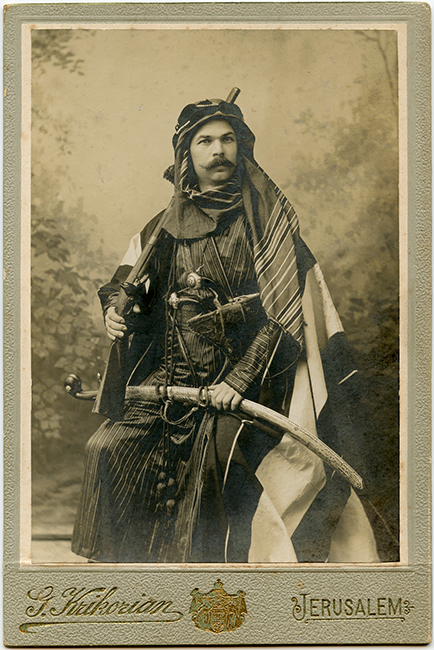 Garabed Krikorian Studio, ca. 1900
Garabed Krikorian Studio, ca. 1900
(Malikian Collection) Garabed Krikorian & Mitry Studio, ca. 1900
Garabed Krikorian & Mitry Studio, ca. 1900
(Malikian Collection) Garabed Krikorian Studio, ca. 1900
Garabed Krikorian Studio, ca. 1900
(Malikian Collection) Unidentified Studio, ca. 1925
Unidentified Studio, ca. 1925
(Malikian Collection) Johannes Krikorian Studio, ca. 1920
Johannes Krikorian Studio, ca. 1920
(Malikian Collection) Johannes Krikorian Studio. Zarouhi Kundikian Deyirmenjian (standing)
Johannes Krikorian Studio. Zarouhi Kundikian Deyirmenjian (standing)
dressed in native Bedouin costume, ca. 1920
(Malikian Collection) Johannes Krikorian Studio, ca. 1920
Johannes Krikorian Studio, ca. 1920
(Malikian Collection) Johannes Krikorian Studio, ca. 1920
Johannes Krikorian Studio, ca. 1920
(Malikian Collection) Johannes Krikorian Studio. Family portrait, ca. 1925
Johannes Krikorian Studio. Family portrait, ca. 1925
(Malikian Collection) Johannes Krikorian Studio. Family portrait with native Palestinian costumes, ca. 1925
Johannes Krikorian Studio. Family portrait with native Palestinian costumes, ca. 1925
(Malikian Collection) Chalil Raad Studio. Sara Raad Nijim dressd in native Palestinian costume.
Chalil Raad Studio. Sara Raad Nijim dressd in native Palestinian costume.
Hand-colored by Najla Nijim Krikorian, ca. 1915
(Courtesy of Alice Krikorian Abusharr) Chalil Raad Studio, ca. 1900
Chalil Raad Studio, ca. 1900
(Malikian Collection)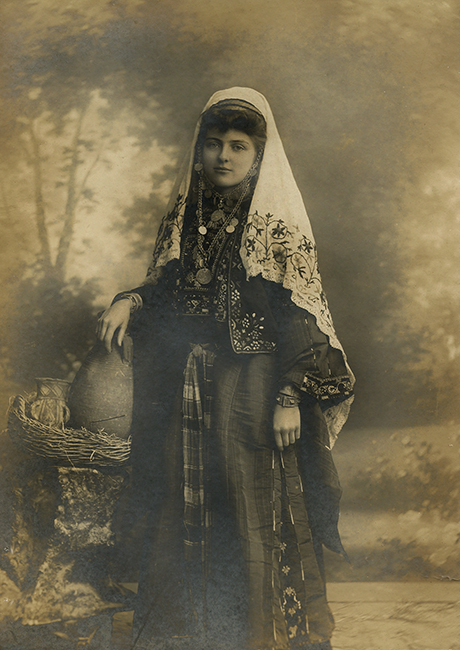 Chalil Raad Studio, ca. 1900
Chalil Raad Studio, ca. 1900
(Malikian Collection) Chalil Raad Studio, ca. 1910
Chalil Raad Studio, ca. 1910
(Malikian Collection) Chalil Raad Studio, ca. 1900
Chalil Raad Studio, ca. 1900
(Malikian Collection) Chalil Raad Studio. Najla Nijim Krikorian dressed in native Bedouin costume, ca. 1910
Chalil Raad Studio. Najla Nijim Krikorian dressed in native Bedouin costume, ca. 1910
(Courtesy of Alice Krikorian Abusharr)
Tap L/R Side of the Slide to Proceed
CONTEXT
View Photo Index
Tourism And Cultural Cross-Dressing In The Palestinian Photographic Studios
During the mid to the latter part of the 19th century and into the early 20th century, there was growing interest in the orient with an influx of western tourists making their way to the Near East to visit holy places and sites of antiquity. Many tourists embarked on the grand tour starting in Constantinople leading to places in the holy lands in the Middle East. With the fairly new medium invention of photography, tourists were buying as souvenirs photographs and albums of these historic sites, the majestic architecture, and views of the Orient. They were also captivated by the very exotic and fascinating images of the inhabitants in their traditional costumes often referred to as “types” by the photographers.
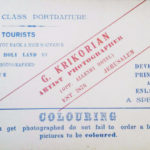
Krikorian Studio advertisement for photographs in native Palestinian costumes, ca. 1920 (Malikian Collection)
There was an interesting and growing trend in photo studios around this period which Barbara Bair has labeled as “cultural cross-dressing” whereby tourists, as she noted, “shed western attire and posed for the camera clad in exotic “orientalist” costumes available for the choosing from the studio wardrobes.” In Palestine, “cultural cross-dressing” offered to the tourists a rather playful and romanticized experience of Palestinian culture and tradition. Many of these photographs showcase native Palestinian costumes with the intricate needle work of Palestinian embroidery. The first photo studio established in Jerusalem by Garabed Krikorian, and the many studios that followed such as Johannes Krikorian and Chalil Raad, produced these images of “cultural cross-dressing.”
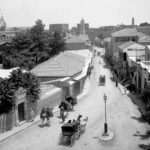
Krikorian Studio on Jaffa Road, Jerusalem, Palestine, ca. 1900
(Matson Collection)
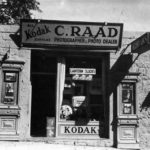
Chalil Raad Studio on Jaffa Road, Jerusalem, Palestine, ca. 1930-40
(The Institute for Palestinian Studies)
Bair, Barbara. The American Colony Photography Department: Western Consumption and “Insider” Commercial Photography. Jerusalem Quarterly 44 (2010): 22-38




